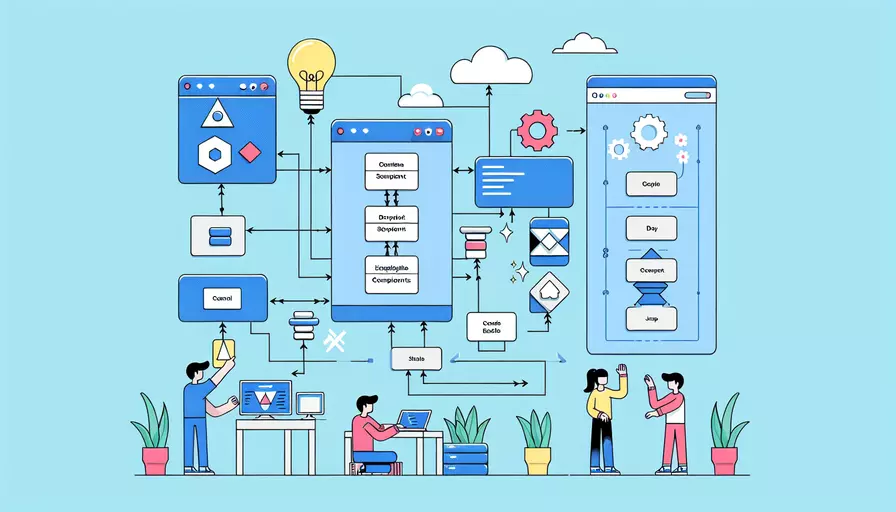
封装Vue组件主要包括以下几个步骤:1、定义组件,2、配置组件,3、注册组件,4、使用组件。 在接下来的部分,我们将详细讨论每个步骤,并解释如何通过封装组件来提高代码的可维护性和复用性。
一、定义组件
定义组件是封装Vue组件的第一步。组件可以是单文件组件(.vue文件),也可以是简单的JavaScript对象。
-
单文件组件:
单文件组件是指一个组件定义在一个单独的文件中,通常以
.vue为后缀。它包括模板、脚本和样式部分。<template><div class="my-component">
<p>{{ message }}</p>
</div>
</template>
<script>
export default {
name: 'MyComponent',
props: {
message: String
}
}
</script>
<style scoped>
.my-component {
color: blue;
}
</style>
-
JavaScript对象组件:
这种形式的组件定义在一个JavaScript对象中,适用于简单的组件。
Vue.component('my-component', {template: '<div>{{ message }}</div>',
props: ['message']
});
二、配置组件
配置组件包括设置组件的属性、方法、计算属性和生命周期钩子等。这部分是组件功能的核心。
-
属性(Props):
属性用于从父组件向子组件传递数据。
props: {message: {
type: String,
required: true
}
}
-
方法(Methods):
方法是组件中定义的函数,用于处理事件或操作数据。
methods: {handleClick() {
console.log('Button clicked!');
}
}
-
计算属性(Computed Properties):
计算属性是基于响应式依赖的动态属性。
computed: {reversedMessage() {
return this.message.split('').reverse().join('');
}
}
-
生命周期钩子(Lifecycle Hooks):
Vue组件提供了一系列的生命周期钩子函数,用于在组件的不同阶段执行代码。
mounted() {console.log('Component mounted!');
}
三、注册组件
注册组件可以是全局注册或局部注册。
-
全局注册:
全局注册的组件可以在任何模板中使用。
import Vue from 'vue';import MyComponent from './MyComponent.vue';
Vue.component('my-component', MyComponent);
-
局部注册:
局部注册的组件只能在注册它的父组件中使用。
import MyComponent from './MyComponent.vue';export default {
components: {
'my-component': MyComponent
}
}
四、使用组件
一旦组件被定义和注册,就可以在模板中使用它。
-
在模板中使用:
使用组件标签将组件嵌入到父组件的模板中。
<template><div>
<my-component message="Hello, World!"></my-component>
</div>
</template>
-
传递数据:
通过属性向子组件传递数据。
<template><div>
<my-component :message="parentMessage"></my-component>
</div>
</template>
<script>
export default {
data() {
return {
parentMessage: 'Hello from parent!'
};
}
}
</script>
五、组件通信
组件通信包括父组件与子组件之间、兄弟组件之间的通信。
-
父子组件通信:
- 父组件向子组件传递数据通过
props。 - 子组件向父组件发送消息通过事件。
<!-- 父组件 --><template>
<div>
<child-component @child-event="handleChildEvent"></child-component>
</div>
</template>
<script>
export default {
methods: {
handleChildEvent(data) {
console.log('Received data from child:', data);
}
}
}
</script>
<!-- 子组件 -->
<template>
<div>
<button @click="sendMessage">Click me</button>
</div>
</template>
<script>
export default {
methods: {
sendMessage() {
this.$emit('child-event', 'Hello Parent!');
}
}
}
</script>
- 父组件向子组件传递数据通过
-
兄弟组件通信:
兄弟组件之间的通信通常通过一个事件总线(Event Bus)来实现。
// event-bus.jsimport Vue from 'vue';
export const EventBus = new Vue();
// 组件A
<template>
<button @click="sendMessage">Send to B</button>
</template>
<script>
import { EventBus } from './event-bus.js';
export default {
methods: {
sendMessage() {
EventBus.$emit('message-event', 'Hello B!');
}
}
}
</script>
// 组件B
<template>
<div>{{ message }}</div>
</template>
<script>
import { EventBus } from './event-bus.js';
export default {
data() {
return {
message: ''
};
},
created() {
EventBus.$on('message-event', (data) => {
this.message = data;
});
}
}
</script>
六、插槽和作用域插槽
插槽用于让父组件向子组件传递结构化内容。
-
默认插槽:
<!-- 子组件 --><template>
<div>
<slot></slot>
</div>
</template>
<!-- 父组件 -->
<template>
<child-component>
<p>This is passed to the child component!</p>
</child-component>
</template>
-
具名插槽:
<!-- 子组件 --><template>
<div>
<slot name="header"></slot>
<slot></slot>
</div>
</template>
<!-- 父组件 -->
<template>
<child-component>
<template v-slot:header>
<h1>Header Content</h1>
</template>
<p>Main content</p>
</child-component>
</template>
-
作用域插槽:
作用域插槽用于在父组件中访问子组件的数据。
<!-- 子组件 --><template>
<div>
<slot :data="message"></slot>
</div>
</template>
<script>
export default {
data() {
return {
message: 'Hello from child!'
};
}
}
</script>
<!-- 父组件 -->
<template>
<child-component v-slot:default="slotProps">
<p>{{ slotProps.data }}</p>
</child-component>
</template>
七、总结与建议
通过以上步骤,您可以高效地封装Vue组件,实现组件的复用和维护。在实际开发中,组件化开发可以显著提高代码的清晰度和可维护性。以下是一些进一步的建议:
- 保持组件简单和单一职责:每个组件应只负责一个功能,避免过于复杂。
- 重用组件:尽可能重用已经封装好的组件,避免重复代码。
- 利用Vue的生态系统:Vue有许多开源的组件库,可以帮助您快速构建应用。
- 关注性能:在封装组件时,注意性能优化,避免不必要的重新渲染。
通过这些建议,您可以更好地利用Vue的组件化机制,构建出高效、可维护的应用程序。
相关问答FAQs:
Q: 什么是Vue组件封装?
A: Vue组件封装是指将一组相关的功能和样式封装成一个独立的组件,以便在Vue应用中复用和维护。通过将代码封装为组件,可以提高代码的可读性、可维护性和重用性。
Q: 如何创建一个Vue组件?
A: 创建一个Vue组件需要以下步骤:
- 创建一个Vue组件的文件,通常以
.vue作为文件扩展名。 - 在文件中使用
<template>标签定义组件的模板。 - 使用
<script>标签定义组件的逻辑,包括数据、方法和生命周期钩子函数。 - 使用
<style>标签定义组件的样式。
Q: 如何在Vue中封装组件?
A: 在Vue中封装组件可以按照以下步骤进行:
- 根据功能和样式的相关性,将组件拆分为多个子组件。
- 在父组件中引入子组件,并在父组件的模板中使用子组件。
- 在父组件的逻辑中,通过props向子组件传递数据和事件。
- 在子组件中,通过props接收父组件传递的数据,并通过emit触发事件向父组件通信。
- 可以在父组件中使用插槽(slot)来插入子组件的内容。
例如,假设我们要封装一个按钮组件:
<template>
<button class="custom-button" @click="handleClick">
<slot></slot>
</button>
</template>
<script>
export default {
methods: {
handleClick() {
this.$emit('click');
}
}
}
</script>
<style>
.custom-button {
/* 自定义样式 */
}
</style>
以上代码定义了一个名为custom-button的按钮组件,它通过插槽(slot)来插入按钮的内容。当按钮被点击时,会触发一个名为click的事件。我们可以在父组件中使用这个自定义的按钮组件,并监听它的click事件来实现特定的功能。
总结:通过以上的步骤,我们可以将功能和样式相关的代码封装为一个独立的Vue组件,提高代码的可复用性和可维护性。
文章标题:如何用vue封装组件,发布者:worktile,转载请注明出处:https://worktile.com/kb/p/3620231

 微信扫一扫
微信扫一扫  支付宝扫一扫
支付宝扫一扫 